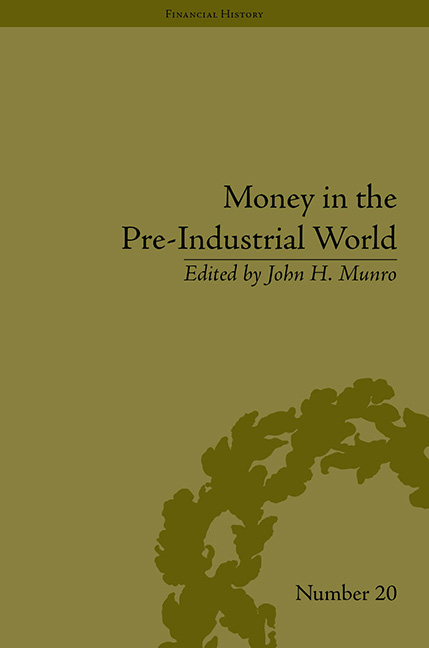Book contents
- Frontmatter
- CONTENTS
- List of Figures and Tables
- List of Contributors
- Introduction
- 1 The Technology and Economics of Coinage Debasements in Medieval and Early Modern Europe: with Special Reference to the Low Countries and England
- 2 From Aurelian to Diocletian: Financing Imperial Recovery by Coinage Debasements and Fiduciary Currencies
- 3 The Making of a Gold Standard: The Ducat and its Offspring, 1284–2001
- 4 Debasement of the Coinage and its Effects on Exchange Rates and the Economy: in England in the 1540s, and in the Burgundian-Habsburg Netherlands in the 1480s
- 5 The Amsterdam Wisselbank's Innovations in the Monetary Sphere: The Role of ‘Bank Money’
- 6 Silver in England 1600–1800: Coinage Outputs and Bullion Exports from the Records of the London Tower Mint and the London Company of Goldsmiths
- 7 The Burdens of Tradition: Debasements, Coinage Circulation and Mercantilist Public Policy Debates in Seventeenth-Century Aragon
- 8 Money or Export Commodity for Asia? American Silver in the Markets of Mexico, Castile and Amsterdam from the Sixteenth to the Eighteenth Century
- 9 Cacao Beans in Colonial México: Small Change in a Global Economy
- 10 Precious Metals, Debasements and Cowrie Shells in the Medieval Indian Monetary Systems, c. 1200–1575
- Notes
- Index
3 - The Making of a Gold Standard: The Ducat and its Offspring, 1284–2001
- Frontmatter
- CONTENTS
- List of Figures and Tables
- List of Contributors
- Introduction
- 1 The Technology and Economics of Coinage Debasements in Medieval and Early Modern Europe: with Special Reference to the Low Countries and England
- 2 From Aurelian to Diocletian: Financing Imperial Recovery by Coinage Debasements and Fiduciary Currencies
- 3 The Making of a Gold Standard: The Ducat and its Offspring, 1284–2001
- 4 Debasement of the Coinage and its Effects on Exchange Rates and the Economy: in England in the 1540s, and in the Burgundian-Habsburg Netherlands in the 1480s
- 5 The Amsterdam Wisselbank's Innovations in the Monetary Sphere: The Role of ‘Bank Money’
- 6 Silver in England 1600–1800: Coinage Outputs and Bullion Exports from the Records of the London Tower Mint and the London Company of Goldsmiths
- 7 The Burdens of Tradition: Debasements, Coinage Circulation and Mercantilist Public Policy Debates in Seventeenth-Century Aragon
- 8 Money or Export Commodity for Asia? American Silver in the Markets of Mexico, Castile and Amsterdam from the Sixteenth to the Eighteenth Century
- 9 Cacao Beans in Colonial México: Small Change in a Global Economy
- 10 Precious Metals, Debasements and Cowrie Shells in the Medieval Indian Monetary Systems, c. 1200–1575
- Notes
- Index
Summary
In the late fourteenth century, a French royal adviser cited the ducat of Venice as a worthy example for his young king to emulate: ‘the fine gold ducat of 24 carats that has not changed its standards for nine centuries’. In fact, the ducat at that point was barely a century old, but it had already impressed itself on the minds of contemporaries as an unchanging standard of immemorial presence. By the time it saw its last issue on the eve of the birth of the euro in 2001, it had indeed survived as the main gold denomination of Europe for the better part of nine centuries.
When authorized in 1284, the ducat standard was not an original invention of Venice; it was a conscious appropriation of the gold coins of identical standard introduced by Florence and Genoa, apparently simultaneously, in 1252. While the genovino had a restricted circulation and would not be copied by other issuers, the florin had great success throughout Europe, partly as a result of the influence of Florentine bankers in collecting papal revenues. Its image of St John (standing) on the obverse and the heraldic lily on the reverse served as the visual model for gold coins for centuries. However, its standard was not universally adopted along with the imagery, and even in Florence its weight was lowered before the end of the thirteenth century.
The Venetian ducat was introduced with an authorization that specifically recalled the standard of the Florentine florin. Like the florin, the ducat was intended to have a fineness as pure as medieval refining technology allowed, generally within a quarter of a carat or about two per cent of absolute purity. The florin was cut at the rate of eight coins to the Florentine ounce, resulting in a coin weight equivalent to about 3.53 grams Venice set the ducat at 67 coins to its marc, which resulted in a slightly heavier standard, about 3.545 g.
- Type
- Chapter
- Information
- Money in the Pre-Industrial WorldBullion, Debasements and Coin Substitutes, pp. 45 - 62Publisher: Pickering & ChattoFirst published in: 2014



